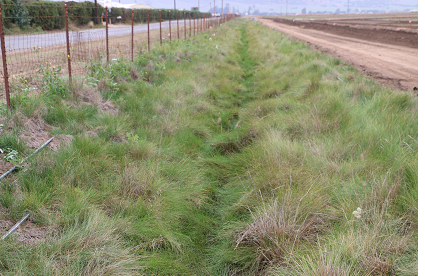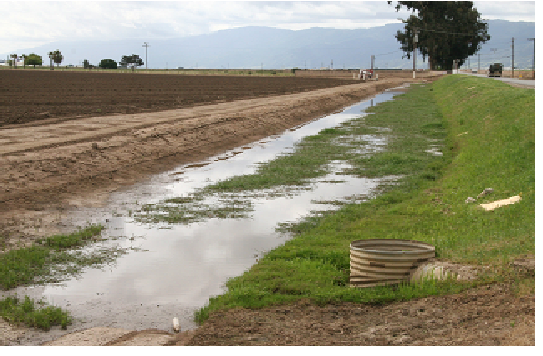Groundwater Recharge on East Side Soils of the Salinas Valley; Part 2
Authors: Richard Smith1, Michael Cahn1, Tamara Voss2, Toby O'Geen3, Eric Brennan4, Karen Lowell5 and Mark Bolda6
1 – UC Cooperative Extension, Monterey County; 2 – Monterey County Water Resources Agency; 3 – Dept of Land Air and Water Resources, UC Davis; 4 – USDA Agricultural Research Service; 5 –USDA Natural Resources Conservation Service; 6 – UC Cooperative Extension, Santa Cruz County.
For access to full report please visit http://cemonterey.ucanr.edu/files/219694.pdf
FIELD-EDGE PRACTICES
Rainfall that cannot be infiltrated within a field will run-off to surrounding areas and eventually flow off-site. Several strategies can capture, slow, and facilitate infiltration of such run-off. In general, strategies become more costly and harder to implement the further downslope they occur. Row arrangement that slows run-off is more cost effective than building large recharge basins that routinely fill with sediment. Full control of run-off almost always requires suites of practices rather than a single approach. Many of the strategies described below are described in more detail in the Resource Conservation of Monterey County and Monterey County Agricultural Commissioner's 2014 publication, Hillslope Farming Runoff Management Practices Guide. This 52 page guide is available as a free download here: http://tinyurl.com/Runoff-Management-Practices.
Permanent Vegetative Cover. In areas of the ranch that routinely receive runoff, establishing permanent vegetative cover is very helpful. While this removes ground from production, if it is a part of a ranch that is routinely damaged by winter rains it may allow management strategies that are worth the sacrificed ground. For example, a grassy area that receives relatively sediment free runoff could serve to defuse energy and infiltrate water and avoid need for regular sediment basin maintenance. Where such an area overlies a soil that allows deep percolation this will lead to groundwater recharge. If permanent cover is not practical or acceptable from an operational perspective, setting aside an area for this purpose that can be planted later in the spring (to allow for more dense vegetation to be disked in) may still be beneficial. Grassed waterways may serve this function, and are typically planted to perennial grasses. Some ranches with wash facilities on site may have areas that receive waste water. Where practical, if water can be carried to this area during rainy winter months when production (and wash activities) are not underway extra benefit of the area may be possible. Vegetated filter strips placed strategically along the contour of a slope may be feasible in some operations, or narrower areas strategically placed to diffuse the energy of water sheeting off a plastic hoop house. For example, seeding this splash impact area to a low grass may keep the soil surface more open and able to infiltrate water than one with poor soil structure resulting from drainage onto bare ground.
Sediment traps: Because significant erosion can occur during major storm events, structures are needed that can minimize clogging of downstream run-off control practices such as vegetated ditches, weirs, and retention basins. Sediment traps can intercept and settle sand and large silt particles suspended in run-off from fields during storm events. These structures are usually shallow basins (2 to 3 feet deep) located at the lower corner of a field. They intercept run-off before it flows into major ditches that convey it across a ranch. Trapped sediment needs to be removed after major storm events for these structures to function efficiently during the winter. A check at the outlet of the trap can be used to adjust the height of water by adding and removing slats of wood. Changing the height of the check dam allows more time to allow for sediment in a heavy flow with resultant high water level, to settle out before overflowing into a culvert or other conveyance.
Enhance ditches for infiltrating run-off: Permanent ditches that convey field run-off can be enhanced to minimize bank erosion during storm events and increase infiltration. Many farm ditches are narrow with steep banks that are prone to erosion and blow-outs during large storm events. Wider ditches with a U-shape instead of a V-shape reduce erosion by spreading the water and reducing the erosive energy as it flows. Water in a wider ditch may also flow more slowly, allowing more opportunity for infiltration and recharge to groundwater. Providing some armor to soil (e.g. rocks) to dissipate the energy of run-off entering from culverts and smaller tributaries can also protect against erosion, although it is important to place such protection carefully to avoid creating paths of preferential flow that may be even more damaging. Weirs can be spaced at regular distances within the ditch to slow the flow of water during moderate run-off events. These weirs can be designed to be removable or so that the cross section of the passage way can be adjusted to handle high flow rates without overflowing the banks of the ditch. During small and medium storm events, weirs can retain and infiltrate a large portion of the run-off.
Vegetating ditches Vegetation in permanent ditches helps protect the banks to prevent erosion, and avoid blow outs with massive volumes of sediment during large, intense storms. Because infiltration is better when there is good surface soil structure, typically the case when there is vegetation, vegetated ditches may also improve infiltration. Key design features will influence the ability of a ditch to retain its function during large storms. For example, as noted above U-shaped ditches are better than V-shaped ditches. A 1:3 to 1:4 slope (1 foot of depth to 4 feet of width) would be a good target to optimize ditch stability and enhance infiltration. Ditches can be seeded with fast growing grasses such as barley or rye if the objective is to have vegetation only during the winter months. Grasses planted in ditches may be killed with an herbicide before they produce seed, to reduce the potential to attract rodents. Also the ditches can be returned to an unvegetated condition before spring crops are planted. Red fescue provides a dense permanent vegetation that has very small seeds that are less attractive to rodents (Figure 7). Studies conducted at the USDA-ARS research station in Salinas demonstrated that these ditches were effective in infiltrating run-off and mitigating transported sediment and pesticides.
Figure 7. Permanent ditch planted with red fescue can infiltrate run-off and protect the sides of the ditch from eroding during large storm events. This ditch is located at the USDA-ARS along Spence Road in Salinas.
Lined Waterway. If vegetation is not sufficient cover for a conveyance channel use of concrete or rock riprap may be necessary. Some growers use plastic. While this reduces recharge potential as the water does not infiltrate from a plastic lined ditch, if it can safely convey the runoff to a suitable basin where infiltration is possible. The reduced sediment load resulting from the lined ditch will be beneficial. Significant recharge depends on placing the basin on a suitable soil and delivery of relatively sediment free water to ensure that the bottom of the basin retains high infiltration rates.
Retention basins: A basin that can retain run-off reaching the lower end of a ranch can provide an additional opportunity to infiltrate storm water (Figure 8). Retention basins designed for infiltrating run-off can be relatively shallow (2 to 4 feet deep), and can be located in areas of the ranch that are undesirable for farming, such as on an irregularly shaped section of a field. For optimum benefit, it is important to consider soil properties underlying the basin. For example, a soil with a hardpan at 3 feet depth will be less effective than one with no impeding layer. A ditch conveying run-off might be widened to create some of the function of a shallow retention basin, or a berm constructed between a field and roadway can create a retention basin. To avoid blow outs, basins must be sized appropriately, based on expected intensity of storm events and size and slope of the area that will drain to them. The outflow structure of the basin should be engineered to allow controlled overflowing during large storm events and to ensure that outflow is channeled to minimize erosion of the basin and any conveyances that receive overflow. Even dead vegetation on the bottom or sides of a ditch can enhance recharge by creating an organic matter layer that protects surface soil structure and facilitates infiltration.
Figure 8. Shallow retention basins can infiltrate run-off from agricultural fields before it flows offsite
Road Protection. Many of the strategies described above will work on roads as well. A few others may also be useful. For example, use of cross ripping or waterbars on roads that do not need to be driven during winter months may be helpful as supplemental protection when roads are seeded for erosion control. A temporary slope drain may also be used when cost, labor or time constraints make construction of underground outlets and permanent sediment basins impractical. These temporary systems use a flexible pipe to capture concentrated runoff at the top of the slope and convey it downslope to a stable outlet where it is released in a sediment basin or similar.
Citations and Other Resources:
Brown and Caldwell, State of the Salinas River Groundwater Basin, prepared for Monterey County Resource Management Agency, January 16, 2015.
Montgomery Watson, Salinas Valley Historical Benefits Analysis, prepared for Monterey County Water Resources Agency, April 1998.
Soil suitability index identifies potential areas for groundwater banking on agricultural lands. O'Geen, T. et al. 2015. California Agriculture. Online:http://californiaagriculture.ucanr.edu/landingpage.cfm?article=ca.v069n02p75&fulltext=yes
Low residue winter cover crops for winter vegetable production. Smith, R., M. Cahn, A. Heinrich and B. Farrara. YouTube video: https://www.youtube.com/watch?v=k0oVVJ_BA7s
Hillslope Farming Runoff Management Practices Guide. This 52 page guide is available as a free download here: http://tinyurl.com/Runoff-Management-Practices.
Local USDA Natural Resource Conservation Service and Resource Conservation Districts have resources to help growers with farm edge practices: Salinas NRCS office: 831-424-1036 x101, Resource Conservation District of Monterey County: 831-424-1036 x124 0r 126.

